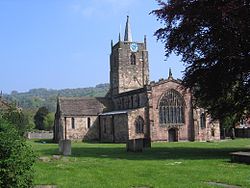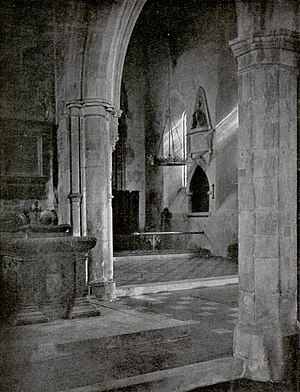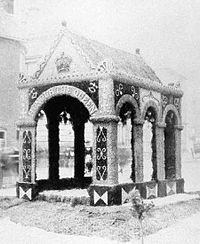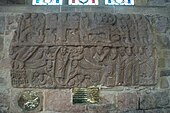Wirksworth
| Wirksworth | |
| Derbyshire | |
|---|---|
 St Mary's Church, Wirksworth | |
| Location | |
| Grid reference: | SK2853 |
| Location: | 53°4’48"N, 1°34’12"W |
| Data | |
| Population: | 9,000 (est.) |
| Post town: | Matlock |
| Postcode: | DE4 |
| Dialling code: | 01629 |
| Local Government | |
| Council: | Derbyshire Dales |
| Parliamentary constituency: |
Derbyshire Dales |
Wirksworth is a market town in Derbyshire, and the largest in the Derbyshire Peak District after Matlock. The Wirksworth wapentake is named after the town. The population of the town and its surrounding villages of Cromford, Bolehill and Middleton-by-Wirksworth is about 12,000.
Wirksworth is listed in the Domesday Book of 1086.[1][2] Within it is the source of the River Ecclesbourne.
The town was granted its market charter by Edward I in 1306. The market is held every Tuesday in the market square. St Mary's Church is believed to date from about AD 653. Historically, Wirksworth developed as a centre for lead mining and later of stone quarrying.
Many of the institutions in the area have connections with the Gell family, of Hopton Hall, whose most famous member was Sir John Gell, 1st Baronet, who fought on Parliament's side in the Civil War. One of his predecessors, Anthony Gell, founded the local grammar school, and one of his successors, Phillip Gell, opened the curiously named Via Gellia (possibly named in allusion to the Roman Via Appia), a road from the family's lead mines around Wirksworth to the smelter in Cromford. The town's comprehensive school is named after Anthony Gell.
Churches
- Church of England: St Mary's Church
- Baptist: Wirksworth Baptist Church
- Methodist: Wirksworth Methodist Church
- Pentecostal (Assembly of God): The Dales Christian Centre
- United Reformed Church: West Derbyshire United Reformed Church
- Roman Catholic: Our Lady and St Teresa's
Early history
During the Carboniferous period (between about 359 and 299 million years ago), Wirksworth was under tropical oceans, thus giving it vast quantities of limestone for quarrying. There is an extensive history of quarrying, which scars the surrounding of the town, whilst Dene Quarry is still operational in the neighbouring village of Cromford.
Close to Wirksworth in Carsington Pastures is the Dream Cave, where the remains of a woolly rhino were found in the late 19th century. An Acheulean handaxe from the Lower Paleolithic has been found at Hopton nearby. From other remains found in the county there would seem to have been human presence at least periodically until the Romans arrived and found a thriving lead industry.
Wirksworth may be the ancient Roman town of Lutudarum, although there is speculation as to the whereabouts of this.[3] In 2009 a team of volunteers excavated near the vicarage for a Roman fort, but failed to find it.[4]
Perhaps the finest building in Wirksworth is St Mary's Church, which was one of the earliest centres of Christian teaching amongst the English; it is believed to date to around 653 AD.

One of the rectors of Wirksworth was Anthony Draycot who served from 1535 until his imprisonment in 1560. Draycott was the judge at the heresy trial of Joan Waste.[5]
Lead mining
Lead mining was certainly flourishing in Roman times. A possible Roman road led to a ford between Duffield and Milford and thence to the garrison at Derventio (Derby) and to Rykneld Street and possibly but not certainly, to the ports on the Humber. In Anglo-Saxon times there were many mines owned by the Abbey of Repton. Three lead mines are identified in the entry for Wirksworth in the Domesday Book.[1]
Every man had the right to dig for ore wherever he chose, except in churchyards, gardens or roadways. All that was necessary to stake a claim was to place one's "stowce" or winch on the site and extract enough ore to pay tribute to the "barmaster." This right remains in theory.
Henry VIII granted a charter to hold a miners' court in the town called the Bar Moot. The present building of that name dates from 1814. Within it is a brass dish for measuring the levy which was due to the Crown. The punishment for stealing from a mine was to have one's hand nailed to the stowce. The Barmote Court is still held today and controls all matters of lead mining.
There is a tiny carving in Wirksworth Church, taken from Bonsall Church during a restoration project and never returned, of a miner with his pick and "kibble" or basket. The carving is known as "t'Owd Man of Bonsall." The ore was washed out by means of a sieve, the iron wire for which had been drawn in Hathersage since the Middle Ages. Smelting was carried out in "boles", hence the name Bolehill. The lead industry, the miner, the ore and the waste, were known collectively as "t'owd man."
By the 18th century there were many thousands of mines, all worked individually. Daniel Defoe[6] gives an eye-witness account of a lead miner's family and of the miner himself at work. At this time, the London Lead Company was formed which brought in the finance to dig deeper mines, with drainage channels, called soughs, and bring in Newcomen steam engine pumps.
There was a workhouse in Wirksworth from 1724 to 1829. Called Babington House, it was located on Green Hill (SK286541) and housed 60 inmates.[7]
Textiles
In 1777, Richard Arkwright leased the land and premises of a corn mill from Philip Gell of Hopton and converted it to spin cotton, using his water frame. The Haarlem Mill was the first cotton mill in the world to use a steam engine, which it used to replenish the millpond that drove the mill's waterwheel.[8][9] This mill was adjacent to another, the Speedwell, owned by John Dalley, a local merchant. These mills still stand close together at Miller's Green next to the Derby road.
The Haarlem Mill was sublet in 1792, when Arkwright's son, Richard, began to sell off the family's property assets in his move toward banking. It was given that name in 1815, when it was converted to weaving tape, by Madely, Hackett and Riley, who had established the Haarlem Tape Works in Derby in 1806. In 1879 the Wheatcroft family, who were producing tape at the Speedwell Mill, expanded into Haarlem.
The two mills together employed 230 people, and it was said that their weekly output equalled the circumference of the earth, and that Wirksworth was the primary producer of red tape for Whitehall.
Both mills still exist. The Haarlem produces narrow fabrics, while the Speedwell produces cavity wall and roof insulation.
Wirksworth today

Districts of Wirksworth include Yokecliffe, Gorsey Bank, Bolehill, Mountford and Miller's Green. Bolehill, although technically a hamlet in its own right in Wirksworth's suburbs, is the oldest and most northern part of the town, while Yokecliffe is a fairly new estate in the western area of the town. Modern houses have recently been built in the Three Trees area and at the bottom of Steeple Grange, this housing estate is called Spring Close.
Fanny Shaw's Playing Field, just out of the centre of town, is the principal recreation area for the north of the town. It houses a new skate park and play area. In the south of the town, there is the "Rec", where there is another children's play area, along with cricket and football pitches.
The town is a popular location from which to explore the Derbyshire Peak District and offers a range of accommodation for visitors, some of it in historic buildings, such 18th century Old Manor House on Coldwell Street and the Old Lock-Up guest house, which dates from 1842. The town also has a grand coach house originally built for Sir Richard Arkwright, but now converted into a holiday cottage. The Wirksworth Heritage Centre is just off Market Place in Crown Yard. The exhibition shows the history of Wirksworth from its prehistoric Dream Cave and woolly rhinos, through its Roman and lead mining histories, to the modern era.
Other nearby attractions include:
- Ecclesbourne Valley Railway,
- Steeple Grange Light Railway
- Peak District National Park
Wirksworth's well dressing was adapted after the arrival of piped water so that not only wells but also taps were decorated.[10]
The study Wirksworth and Five Miles Around includes census information, notes on church monuments, accounts of crimes, church wardens' accounts, maps, a transcription of "Ince's pedigrees", monument inscriptions and old photographs, parish registers and wills.

Events
- Early June: The Wirksworth well dressing and carnival.[11]
- First Sunday after 8 September: The clipping or clypping of the church is an ancient custom where the congregation joins hands to encircle the building. This takes place on the Sunday after 8 September (formerly marked as the birthday of St Mary the Virgin, to whom the church is dedicated).
- September: Wirksworth Festival of arts is held over three weeks in September.[12]
Wirksworth in literature and popular culture
- George Eliot: The Haarlem Mill has been mentioned as the possible model for The Mill on the Floss. In Adam Bede, the town of Snowfield is said to be based in Wirksworth; Dinah Morris, a character in that novel, is based on Eliot's aunt, who lived in Wirksworth and whose husband ran the silk mill, now Wirksworth Heritage Centre.
- D H Lawrence had a house here, Mountain Cottage, in which he lived with his wife Frieda in 1918–19. It stands on the outskirts of Middleton-by-Wirksworth, approximately 1½ miles northwest of Wirksworth. Lawrence also reputedly spent a lot of time at Woodland Cottage on the opposite side of New Road. While staying in Middleton in the bitter winter of 1918–19, Lawrence wrote the short story "A Wintry Peacock" (published in 1921).
- Television:
- Sweet Medicine (ITV, 2003), uses Wirksworth as its prime location.
- Peak Practice', forerunner of the above used Wirksworth also.
- Mobile was filmed on a train on the Ecclesbourne Valley Railway.
- Middle Peak Quarry on the outskirts of Wirksworth featured in the 2010 music video "Unlikely Hero" by The Hoosiers.
Outside links
- Wirksworth Dot Net - Community web site
- The Wirksworth Heritage Centre
- Discover Derbyshire and the Peak District: Wirksworth
- Wirksworth Parish Records 1600-1900
- Ecclesbourne Valley Railway
- Anthony Gell School
- Wirksworth Federation of Infant Schools
- St. Osyth's Wirksworth Roman Project
- Wirksworth Festival
References
- ↑ 1.0 1.1 Domesday Book: A Complete Translation. London: Penguin, 2003. ISBN 0-14-143994-7 p.741
- ↑ Outlying farms or berwicks were Cromford, Middleton, Hopton, Wellesdene (sic), Carsington, Kirk Ireton and Callow.
- ↑ Anton Shone: Origins and History of Wirksworth: Lutudarum and the Peak District before the Norman Conquest
- ↑ St Osyth's College
- ↑ Gordon Goodwin, 'Draycot, Anthony (d. 1571)', rev. Andrew A. Chibi, Oxford Dictionary of National Biography, Oxford University Press, 2004 accessed 28 Feb 2009
- ↑ Daniel Defoe's Tour Through the Whole Island of Great Britain, 1726 (Letter 8, Part 2: The Peak District)
- ↑ Higginbotham, P. (2007), Workhouses of the Midlands, Tempus, Stroud. Page 27. ISBN 978-0-7524-4488-8
- ↑ Fitton, R. S. (1989), The Arkwrights: spinners of fortune, Manchester: Manchester University Press, p. 57, ISBN 0-7190-2646-6, http://books.google.co.uk/books?id=jWW7AAAAIAAJ, retrieved 2010-08-14
- ↑ Tann, Jennifer (July 1979), "Arkwright's Employment of Steam Power", Business History 21 (2): 248, doi:10.1080/00076797900000030, http://www.informaworld.com/10.1080/00076797900000030, retrieved 2010-08-14
- ↑ Wirksworth Carnival
- ↑ Wirksworth Carnival
- ↑ Wirksworth Festival